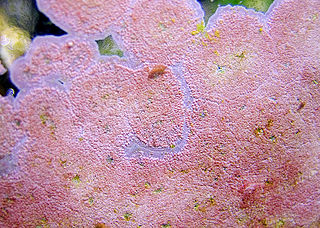
The Sipuncula or Sipunculida is a class containing about 162 species of unsegmented marine annelid worms. Sipuncula was once considered a phylum, but was demoted to a class of Annelida, based on recent molecular work.

Coralline algae are red algae in the order Corallinales. They are characterized by a thallus that is hard because of calcareous deposits contained within the cell walls. The colors of these algae are most typically pink, or some other shade of red, but some species can be purple, yellow, blue, white, or gray-green. Coralline algae play an important role in the ecology of coral reefs. Sea urchins, parrot fish, and limpets and chitons feed on coralline algae. In the temperate Mediterranean Sea, coralline algae are the main builders of a typical algal reef, the Coralligène ("coralligenous"). Many are typically encrusting and rock-like, found in marine waters all over the world. Only one species lives in freshwater. Unattached specimens may form relatively smooth compact balls to warty or fruticose thalli.

The yellow boxfish is a species of marine ray-finned fish belonging to the family Ostraciidae, the boxfishes. This species is found in reefs throughout the Pacific Ocean and Indian Ocean as well as the southeastern Atlantic Ocean. Recorded occasionally since 2011 in the Levantine waters of the Mediterranean Sea which it likely entered via the Suez Canal, it is a species appreciated in the aquarium trade.

Golfingia vulgaris is a marine invertebrate belonging to the phylum Sipuncula, the peanut worms. It is a cylindrical, unsegmented worm with a crown of tentacles around the mouth. It lives in burrows in shallow seas in various parts of the world.

Aspidosiphonidae is a family of peanut worms. It is the only family in the monotypic order Aspidosiphonida, which is in the class Phascolosomatidea.

Brachidontes pharaonis is a species of mussel from the family Mytilidae. It is native to the Indian Ocean and the Red Sea, and has colonised the Mediterranean Sea where it is regarded as an invasive species.

Cheilodipterus novemstriatus, the Indian Ocean twospot cardinalfish, is a species of ray-finned fish from the Indian Ocean, which is a member of the family Apogonidae. It has colonised the eastern Mediterranean Sea by way of the Suez Canal since 2011.

Apogonichthyoides pharaonis, commonly known as the Pharaoh cardinalfish, is a species of cardinalfish from the family Apogonidae which is found the western Indian Ocean and Red Sea. It is one of a group of species which have colonised the eastern Mediterranean Sea from the Red Sea via the Suez Canal, a process known as Lessepsian migration.
Nephasoma minutum is a marine invertebrate of the phylum Sipuncula, commonly known as peanut worms because of their shape when contracted. It is a cylindrical, unsegmented worm with a crown of tentacles around the mouth. These worms live in crevices in the rocks or in burrows in shallow water in Western Europe, and the eastern United States.
Nephasoma rimicola is a marine invertebrate belonging to the phylum Sipuncula, the peanut worms. This worm occurs in the northeastern Atlantic Ocean.

Priapulus caudatus known as the cactus worm, is a marine invertebrate belonging to the phylum Priapulida. It is a cylindrical, unsegmented worm which burrows in soft sediment on the seabed. It has a circumpolar distribution.
Phascolosoma granulatum is a species of peanut worm in the family Phascolosomatidae. It is found in shallow water in the northeastern Atlantic Ocean and the Mediterranean Sea.

Aspidosiphon muelleri is a species of unsegmented benthic marine worm in the phylum Sipuncula, the peanut worms. This worm is found in the eastern Atlantic Ocean, the Mediterranean Sea and in various locations in the Indo-Pacific region at depths down to about 1,000 m (3,300 ft).

Sipunculus robustus is a species of unsegmented benthic marine worm in the phylum Sipuncula, the peanut worms.
Themiste cymodoceae is a species of unsegmented benthic marine worm in the phylum Sipuncula, the peanut worms. It is native to shallow waters around Australia and in the South China Sea where it lives in a cavity it creates among seagrass roots and in empty oyster shells.
Themiste hennahi is a species of unsegmented benthic marine worm in the phylum Sipuncula, the peanut worms. It is native to shallow waters on the Pacific coast of North and South America. This worm was first described in 1828 by the British zoologist John Edward Gray as Themiste hennahi, the type specimen having been collected by the Rev. W. Hennah, with the type locality being Peru.

Themiste pyroides is a species of unsegmented benthic marine worm in the class Sipuncula, the peanut worms. It occurs in the intertidal zone and shallow water in the western Atlantic Ocean and the northeastern Pacific Ocean. It lives in crevices and under rocks, extending its "crown" of branching tentacles into the surrounding water to feed.
Thysanocardia procera is a marine invertebrate belonging to the phylum Sipuncula, the peanut worms. It is a cylindrical, unsegmented worm with a crown of tentacles around the mouth. It is native to shallow seas in the northeastern Atlantic Ocean.

Pteragogus trispilus is a species of marine ray-finned fish from the wrasse family, the Labridae. It is native to the Red Sea from where it has entered the Mediterranean Sea.











